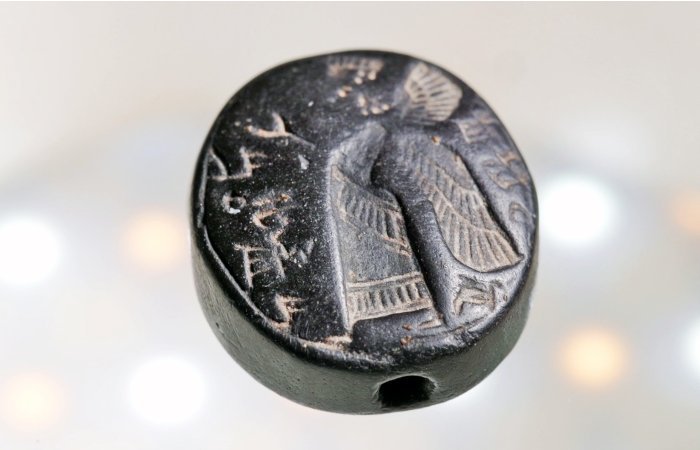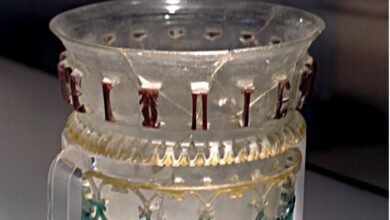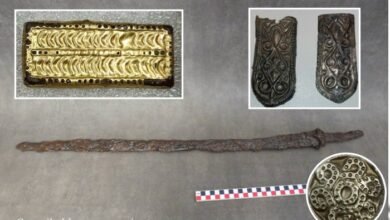Extremely Rare 2,700-Year-Old Black Stone Seal Depicting A Winged Genie Discovered In Jerusalem

Jan Bartek – AncientPages.com – A significant archaeological discovery has been made near the Temple Mount’s Southern Wall, specifically within the Davidson Archaeological Garden in Jerusalem, Israel. This find, dating back to the First Temple period approximately 2,700 years ago, consists of an exceptionally rare stone seal. The artifact, unearthed during excavations conducted jointly by the Israel Antiquities Authority and the City of David organization, bears an inscription in paleo-Hebrew script and features a winged figure.
Credit: Israel Antiquities Authority
The seal, which served a dual purpose as both an amulet and a legal signatory device, exhibits several noteworthy characteristics. It possesses convex cuts on both sides and a longitudinal perforation, suggesting it was designed to be worn as a pendant. The central motif depicts a profile figure, potentially representing a monarch, adorned with wings and attired in a long, striped garment.
This figure is portrayed in a rightward stride, with distinctive features including an elongated, curled mane extending to the nape of the neck and headwear resembling either a hat or a crown. The figure’s arm is extended forward, palm open, possibly indicating the presence of an object in hand.
Credit: Israel Antiquities Authority
Flanking the central figure is an inscription in paleo-Hebrew script, which reads “LeYeho’ezer ben Hosh’ayahu.” It is worth noting that the engraving on this seal employs mirror writing, a technique that further underscores its rarity and historical significance.
“The seal, made of black stone, is one of the most beautiful ever discovered in excavations in ancient Jerusalem, and is executed at the highest artistic level,” Dr. Yuval Baruch and Navot Rom, excavation directors on behalf of the Israel Antiquities Authority said in a press statement.
Israel Antiquities Authority Archaeologist and Assyriologist Dr. Filip Vukosavovic, who studied the seal, said, “This is an extremely rare and unusual discovery. This is the first time a winged ‘genie’ – a protective magical figure – has been found in Israeli and regional archaeology. Figures of winged demons are known in the Neo-Assyrian art of the 9th-7th Centuries BCE, and they were considered a kind of protective demon.”
Credit: Israel Antiquities Authority
The researchers believe that the object upon which the demon image originally appeared was worn as an amulet around the neck of a man named Hosh’ayahu, who held a senior position in the Kingdom of Judah’s administration. By virtue of his authority and status, this Hosh’ayahu allowed himself to ennoble himself and flaunt a seal with an awe-inspiring figure engraved on it—one embodying a symbol of authority.
“It seems that the object was made by a local craftsman – a Judahite, who produced the amulet at the owner’s request. It was prepared at a very high artistic level,” says Dr. Vukosavović.
The hypothesis is that upon Hosh’ayahu’s passing, his son Yeho’ezer inherited the seal, and then added his name and his father’s name on either side of the demon. This he did, perhaps, to directly appropriate to himself the beneficial qualities he believed the talisman embodied as a magical item.
The name Yeho’ezer is familiar to us from the Bible (Chron. I 12:7) in its abbreviated form – Yo’ezer, one of King David’s fighters.
Also, in the book of Jeremiah (43:2), describing the events of this very period, a person is mentioned with a parallel name, ‘Azariah ben Hosh’aya. The two parts of his first name are written in reverse order to the seal owner’s name, and his second name is the same, appearing in its abbreviated form. This writing form in the text fits the name on the newly discovered seal and it is thus appropriate for this time period.
“Comparing the shape of the letters and the writing to those of other Hebrew seals and bullae (clay seal impressions) from Jerusalem shows that, in contrast to the careful engraving of the demon, inscribing the names on the seal was done in a sloppy manner. It is not impossible that perhaps it was Yehoʼezer himself who engraved the names on the object,” Professor Ronny Reich from the University of Haifa said.
This is further evidence of the reading and writing abilities that existed in this period,” says Dr. Yuval Baruch, excavation director and Deputy Director of Archaeology at the Israel Antiquities Authority.
“Contrary to what may be commonly thought, it seems that literacy in this period was not the realm only of society’s elite. People knew how to read and write – at least at the basic level, for the needs of commerce. We know of many written seal impressions, in paleo-Hebrew script, from the environs of the City of David and the Kingdom of Judah.”
“The figure of a winged man in a distinct Neo-Assyrian style is unique and very rare in the glyphic styles of the late First Temple period. The influence of the Assyrian Empire, which had conquered the entire region, is clearly evident here,” adds Dr. Baruch.
Credit: Israel Antiquities Authority
“Judah in general, and Jerusalem in particular at that time, was subject to the hegemony of the Assyrian Empire and was influenced by it – a reality also reflected in cultural and artistic aspects. That the seal’s owner chose a demon to be the insignia of his personal seal may attest to his feeling that he belonged to the broader cultural context – just like people today in Israel, who see themselves part of Western culture.
Yet within that feeling, this Yehoʼezer also held firmly onto his local identity; thus, his name is written in Hebrew script, and his name is a Hebrew name, which belongs to Judah’s culture. In recent years, the archaeological evidence has been increasing – especially in the City of David excavations and at the base of the Temple Mount – and is instructive regarding the extent of the influence of the Assyrian culture in our region, especially in Jerusalem.”
See also: More Archaeology News
“The spectacular and unique find discovered in the excavations of the Israel Antiquities Authority and the City of David opens another window for us into the days of the Kingdom of Judah during the First Temple period and attests to that administration’s international connections. In doing so, it demonstrates the importance and centrality of Jerusalem already 2700 years ago.
It is impossible not to be moved by such an unmediated and direct encounter with a chapter of our past, a time in which the First Temple stood in all its glory,” Israeli Minister of Heritage Rabbi Amichai Eliyahu said, welcoming the discovery.
Written by Jan Bartek – AncientPages.com Staff Writer








